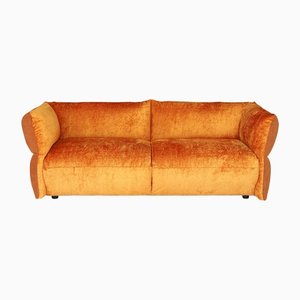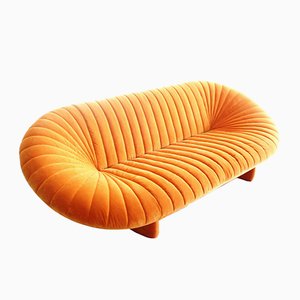
With bold, intelligent designs and an eye-popping palette, Giovannetti produces beautifully articulated furniture pieces with a strong sense of fun.
Giovannetti Collezioni was founded in 1965 in Pistoia, Tuscany, by Benito Giovannetti. The company’s approach is founded on the tenets of high-level industrial design, and a combined spirit of invention and quality workmanship have been evident since its early years, which included collaborations with designer Roberto Tapinassi and Florence-based architecture firm Superstudio. In 1970, global accolades came with the success of the Anfibio convertible sofa, intelligently designed by Alessandro Becchi (1946–87). Awarded with the Compasso d’Oro for industrial design at the Milan Triennale in 1972, its comfortable, malleable form has gone on to achieve cult status–sold in tens of thousands, it has been exhibited in thirteen museums worldwide.
Giovannetti’s output, since its foundation, is consistently playful–its bright palettes, jigsaw-like configurations, and inflated forms are warmly reminiscent of childhood toys, while the confidently executed shapes exude evocations of abstract sculpture. Most of their objects, moreover, are available in a wide array of color and textile combinations, incorporating the buyer’s tastes into the manufacturing process. The Flower armchair (2004), designed by Sandro Santantonio, offers a beautifully abstracted interpretation of the form; a steel frame upholstered in shape-retaining polyurethane foam, it rises from a base plate to blossom outwards, into a structure that is both functional and sculptural. The Multilove sectional sofas (2006), meanwhile, designed by Enrico Buscemi and Piergiorgio Leone of the Space Time design group, generate seating arrangements from the assembly of abstract elements, which joyously illustrate the dynamic curvature of the overarching composition. The Bolle chair (2008), designed by Sergio Giobbi and available in a wide array of colors, is produced in soft curves. Italian for “bubble”, it appropriately resembles the shifting contours of something soft and free-floating. The Anemone armchair (2011), designed by Giancarlo Zema, continues this trend for brightly interpreted natural forms. Thoughtfully recalling the densely distributed tentacles of the marine plant, the chair’s shape is warm, elegantly rendered, and fun.
Furniture pieces by Giovanetti are included in permanent collections all over the world, including theMuseum of Modern Art, New York; Philadelphia Museum of Art; Rufino Tamayo Museum, Mexico City; the Victoria and Albert Museum, London; Tel Aviv Museum of Art; Power House Museum, Sydney; and Museo della Farnesina, Rome. Since its inception, the company has participated in international exhibitions in Paris, Moscow, Seoul, Tokyo, Chicago, Malmö, Warsaw, London, and Dubai. Along with the Compasso d’Oro, it is the recipient of the Young & Design Gold Medal (2003), Young & Design Special Mention (2004, 2005, 2006), and the First Prize at Abitare il Mare (2006), for the staging of a luxury cabin.


















